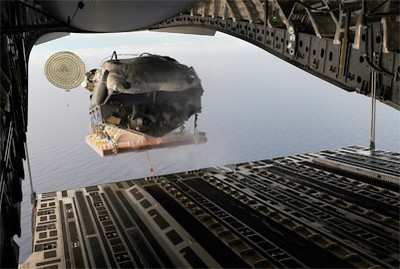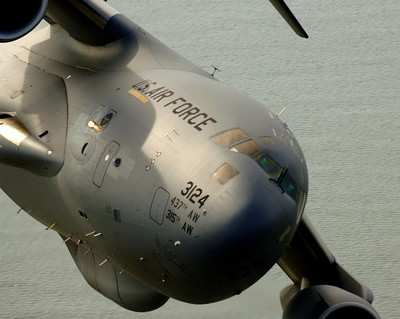The Globemaster Arrived At The Pre-Coordinated Drop Zone To
Find Good Conditions For The Training Exercise
It was before dawn, and only the blue line of runway lights met
the joint Air Force and Navy crew under the wings of a C-17
Globemaster III. A 535th Airlift Squadron aircrew from Joint Base
Pearl Harbor-Hickam, Hawaii, and the U.S. Navy Special Warfare Unit
One from Guam recently teamed up to drop a boat out of the back of
a C-17 using the Maritime Craft Aerial Delivery System.

U.S. Air Force Photo
With more than 19,000 pounds locked in, and parachute riggings
in place, the joint team strapped in was ready to go. The weather
was ideal, the sea state was low and the jet had no maintenance
issues. The training stage was set and execution was the only thing
on their minds. "This training is so important for forging and
refining joint capabilities in the Pacific," said Capt. Alan
Partridge, a 535th AS C-17 pilot. "The (Naval Special warfare Unit
One) is extremely good at what they do, but don't have dedicated
aerial delivery. The 535th is a fully capable airland and airdrop
C-17 squadron in Hawaii with boat-drop-qualified aircrews. The more
we train together, the more prepared we will be for (U.S. Pacific
Command) and (U.S. Special Operation Command, Pacific) to leverage
their assets in response to the challenges of the future."
The Maritime Craft Aerial Delivery System is an airdrop
insertion capability for Naval Special Warfare Rigid-hull
Inflatable Boats and Special Operation Forces personnel employing
Air Force aircraft. The system provides the special-operations
community the ability to deploy the specially designed boat beyond
the range of detection systems such as radar, infrared or thermal
enhancement, acoustical sensors, human intelligence, signal
intelligence and active patrols. "With today's military going
joint, it is essential that we merge our technologies and
capabilities," said Senior Master Sgt. Chuck Baker, the 15th Wing
plans and programs superintendent and airdrop loadmaster. "Each
branch has their own specialties, but we need each other to make
the overall mission a success. This is why the training in Guam was
so important. You never know when that call will come to fly down
and pick up our Navy counterparts to go do a mission."
The C-17 arrived on the pre-coordinated drop zone and found good
conditions for the training exercise. When all signs pointed toward
a green-light drop, the pilots lined up the plane along the
designed flight path. The loadmasters opened the ramp in the back.
The 15-foot drogue chute was released, fluttering in the wind
behind the plane. Once it was released, a 25-foot drogue parachute
pulled the boat out of the back of the plane, with nine
high-altitude, low-opening jumpers immediately following.

C-17 Globemaster III File Photo
Upon free fall, the MCADS is rigged on a 21-foot buoyant
platform that separates from the boat. Four 100-foot parachutes
deploy to safely descend the boat to the water's surface. The
platform also has its own recovery parachute. Once the boat hits
the water, the parachutes separate automatically using water
activated release mechanisms. The platform also has removable
buoyancy if the mission requirements do not have the capability of
recovering the platform.
"It was a complete success," Captain Partridge said. "From an
Air Force perspective, we accomplished all of our planned training
and increased our boat drop qualified pilot and loadmaster force
for (JB Hickam)."
The loadmaster echoed the pilot's opinion, only from a different
point of view.
"This drop went extremely well," Sergeant Baker said. "Anytime
you can drop a piece of equipment and personnel from the aircraft
safely, and without any damage or injury, then, in my opinion, it
was a successful drop."
The flight profile for the delivery of the MCADS takes the
aircrew to 3,500-feet for free fall parachutists, or 1,250-feet for
static-line jumpers. No matter what the scenario, the JB Hickam
aircrew will put the C-17 through its paces to be a force
multiplier.
 ANN's Daily Aero-Term (04.28.24): Airport Marking Aids
ANN's Daily Aero-Term (04.28.24): Airport Marking Aids Aero-News: Quote of the Day (04.28.24)
Aero-News: Quote of the Day (04.28.24) ANN's Daily Aero-Linx (04.28.24)
ANN's Daily Aero-Linx (04.28.24) Aero-News: Quote of the Day (04.29.24)
Aero-News: Quote of the Day (04.29.24) ANN's Daily Aero-Linx (04.29.24)
ANN's Daily Aero-Linx (04.29.24)




